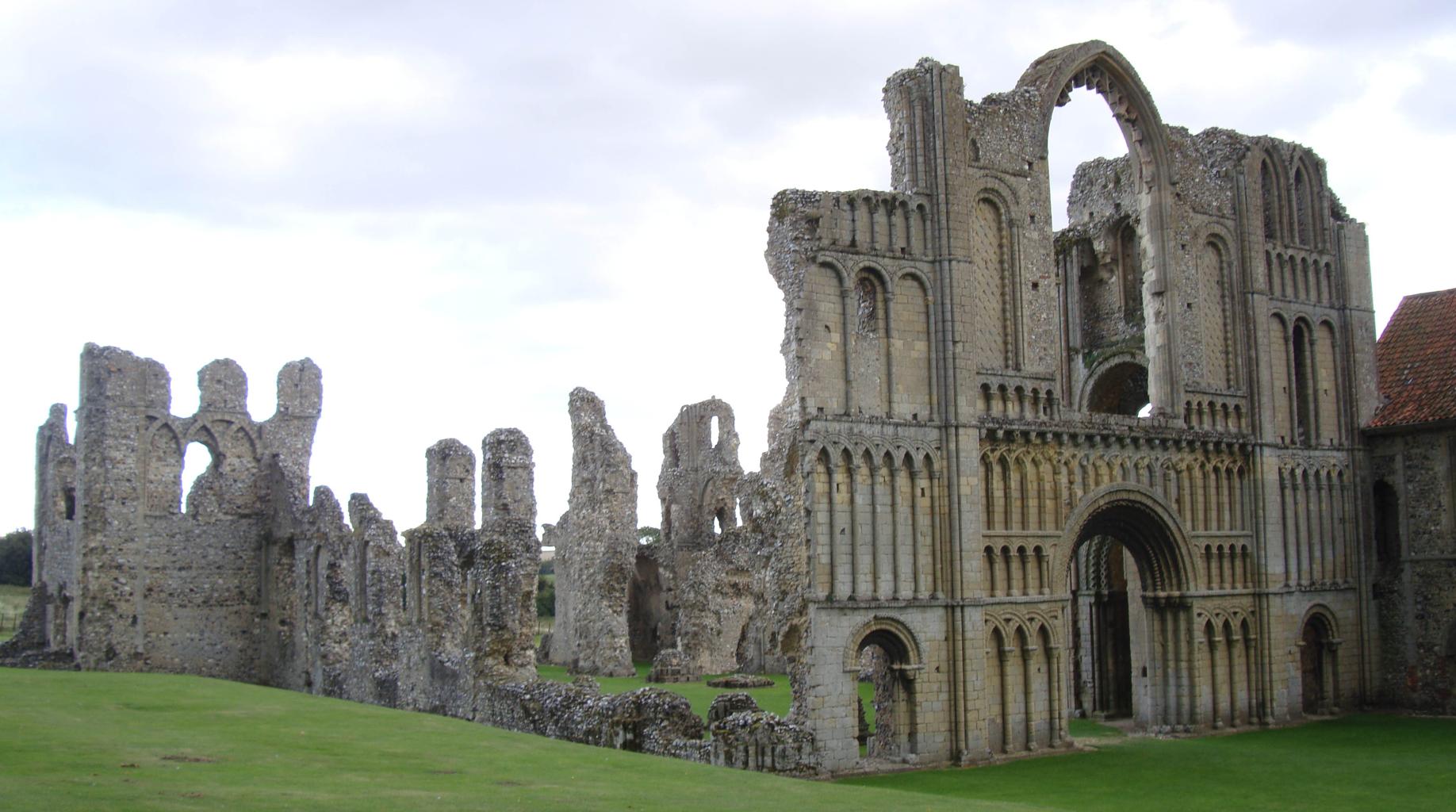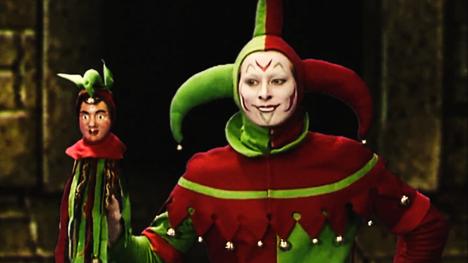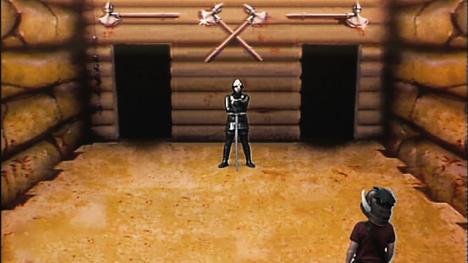The second part of Tim Child's official history of Knightmare explores the changes that took place over its eight-year run.
Despite quick changes between dungeon scenes (thanks to the grid pattern), gameplay was slow and players were spending several days in the dungeon, even on an unsuccessful quest.
At first, I had written and planned each adventure, together with all its options and clues, as a single unbroken interactive narrative. But this proved extremely wasteful.
The cast had to learn each adventure from top to bottom. And when a team failed in Level 1, the entire adventure script was discarded.
Older cast members such as John Woodnutt (Merlin) became confused about which speeches they should be learning.
Eventually, I solved this problem by plotting each new game on a level-by-level basis. The dungeon was already divided into three layers:
- Level 1, easy/introductory
- Level 2, tricky/eliminatory
- Level 3, hard/final.
A new team would start with an unused Level 1 script. If they completed it, the producers picked up the next available Level 2 script, and so on. No objects were carried over from level to level, and the gameplay improved accordingly. The cast were a lot happier too!
1988: A breakthrough in computer graphics
Meanwhile, Robert Harris, whose Travelling Matte company had hitherto played a minor role in proceedings (with David Rowe hand-painting all the scenes) made a breakthrough.
Harris had recently taken delivery of a 16-bit Spaceward Computer. He discovered that if you placed a (black) colour overlay across the frame-grabbed dungeon picture, you could airbrush through the black to progressively reveal the scene beneath. (Similar to how picture restorers delve beneath modern paintings to see if the canvas has been previously used.)
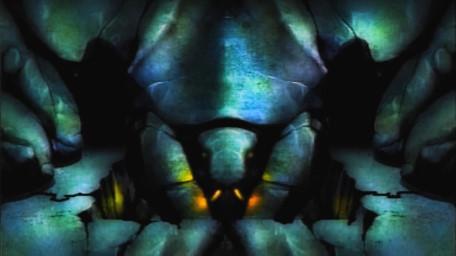
Harris, who had trained as a conventional theatre and TV set designer, found that he could use this technique to 're-light' the computer-hosted scenes. The results were moody and atmospheric and just what Knightmare needed.
The technique was also one of many 'world-firsts' that Knightmare was to be credited with.
From that point onwards, David Rowe produced his new dungeon art with 'bland and even' lighting plots, allowing the new technique to affect the graphics. The Travelling Matte also used cyclic colour animation routines to add animated content into the scenes.
But the dungeons themselves remained frustratingly static.
1990: Outside the dungeon, on location
Gameplay and programme-making flourished. A young British audience was getting used to the only game on television where losing was considered more natural than winning!
By 1990, Knightmare had enjoyed its third series and the first French version, Le Chevalier du Labyrinth, had been commissioned and recorded. But Child was becoming increasingly frustrated with the room-by-room format.
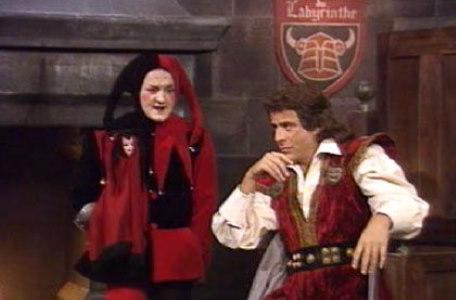
Series 3 (1989) had explored the limits of a solitary blindfolded dungeoneer being guided around a double-garage sized dungeon chamber. These limits weren't confined to the number of chambers David Rowe could paint or the number of scenes which Robert Harris and his computer graphic artists could animate.
Knightmare demanded movement, danger, atmosphere and a complex variety of scenes in which to stage the game. The Greater Game was becoming ever hungrier, ever more demanding, of a greater fantasy world with scenic complexity. But Harris and Rowe were at the limit of what could be achieved by computer or paintbrush.
Virtual Reality offered a possible solution. But when I tried it in my sci-fi adventure show The Satellite Game for British Satellite Broadcasting (BSB), the results from the early runtime images were too poor to be considered. Knightmare had started as hi-fidelity imaging and had to remain that way.
So, if Virtual Reality couldn't do the trick, what about plain reality? Britain has a rich history of medieval castles and ruined abbeys with real crumbling dungeons. Harris's relighting techniques could be used with any images, real or painted – so why not acquire a huge dungeon database by looting history?
The famed Knightmare studio grid pattern was duly reverse-engineered as an acquisition method, and the team went on location, equipped with video cameras, in search of castles.
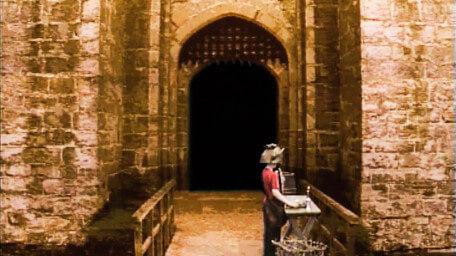
From Kent to Wales, the team plundered, filmed and photographed. And what treasure they discovered, including ancient dwellings at the Weald and Downland Open Air Museum in Sussex, alongside caves and lakes and barns.
On screen, the results were mixed. Try though we might to 'treat' the real material with digital effects and blend them into the graphics that had so far sustained Knightmare, we could not prevent the style clash which followed.
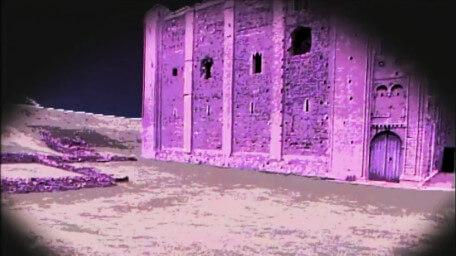
The result, in terms of production design, was a disaster. But by improving the programme and game dynamics we saved Knightmare from the axe and bought ourselves the opportunity for a further development cycle.
1991: The Fear Factor
It's hard to explain to those who consume adventure games by playing or viewing, but the biggest opposition we faced as programme-makers was not from TV execs who thought the game too hard but from those who found it too slow!
A lot of TV is about pace, much of it deliberately and cynically artificial, whereas a good adventure game is almost always slow and must compensate for this by atmospherics.
Knightmare was accused of being 'pedestrian', and how could we deny it? You walked into one room, stood about for a bit, and then walked off into another.
By using TV cameras to acquire new scenery, we had also acquired walkways, journeys, and of course, movement. Soon we were to commission our first dragon and Helifilms were to create the flights of Smirkenorff.
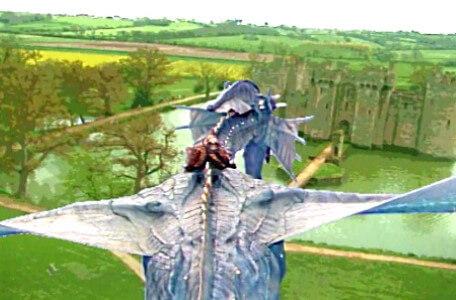
You could argue (and many have) that such location-acquired journeys (we call them 'passive paths') offer less in terms of interactive choice than the prospect of exploring one of David Rowe's painted patios. And of course, you would be right.
To compensate for this, I became determined to sustain and even improve the interactive elements we could deliver. If it was less important which destination you chose, then what must be critical is how you conduct yourself when you get there. This also translated into: 'it's not where you go it's who you meet'.
In adventure gaming, every new solution tends to expose a new problem. If we needed higher levels of interactive drama then we needed stronger interactors, with powerful personalities and sub-plots to justify their activities.
In spring 1991, I auditioned in London for the new Knightmare cast. The Merlin/Mogdred scenario was exhausted (I had always found it annoyingly derivative), and I was convinced that the drama game engine of Knightmare must be driven by a really solid baddy.
When Mark Knight walked into the audition room, he certainly didn't look the part. He was slightly plump, far from muscular, and of medium height. Within 10 minutes, however, I became convinced that Mark was our missing weapon.
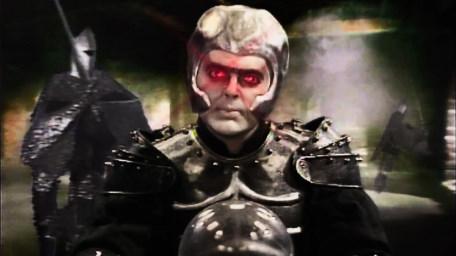
It is not just those crows-wing eyebrows, or the natural mocking, sneering tones. There is a genuine competitiveness in Mark which dictates that no scene or role is too difficult, no character part too demanding, nothing beyond him.
As a great natural competitor, the adventure game is made for Mark. No-one, not even Hugo Myatt, attacked the tasks with such zeal. I was to discover later that this was a very genuine addiction to the interactive genre, because Mark is otherwise quite a lazy person.
There was another unlooked-for bonus: Mark demanded access to, and contact with, the games players to engage with the production.
Obviously, he could not do this as Lord Fear (save for Final Encounters), so together we created a variety of other dungeon characters for him to exploit.
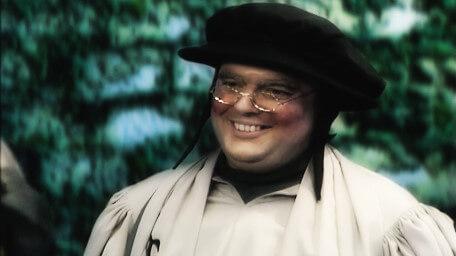
Although comedy was not our prime ambition, the player encounters with Mark opened a rich comedic vein. Only the antics of Paul Valentine as the scurrilous Sly Hands could compete.
1991-93: Exploring the limits of gaming
And so, to gaming. Now we had a dungeon with narrative, conflict, and a rich cast of characters capable of delivering help, threats, larceny, mayhem and a rich colourful cocktail of comedy and corruption.
Mix in a selection of bright, committed teams, and the results could get interesting.
What's more, we were now driving the gameplay with drama-based clues. The spyglasses allowed this, and I defend the need to introduce them. (By the way, I also hated the Eye Shield.)
Knightmare was a fearful taskmaster, and while it gave its creator enormous pleasure, it never provided me with satisfaction. Many of the directions Knightmare took were driven by a needs-must principle that conflicted with my own ambitions for a consistent, integrated design and a 'no limits' attitude towards interactive options.
Writers like Phil Colvin have made some very intuitive observations about the game - remarkably so considering they were not provided, as now, with these background details. If only they could have known the political tightropes and broken glass we treaded.
Because of the success of Knightmare, Broadsword was in-demand as a production company to repeat that success in other areas. In 1990, we were commissioned by the new satellite company, BSB, to produce a new TV sci-fi adventure game.

We produced 38 episodes of The Satellite Game, which was transmitted throughout 1990 and watched (thankfully) by a tiny audience. It was not completely awful, but it was fairly dreadful! It suffered badly from my own attempts to make it as unlike Knightmare as possible and from the fact that early runtime Virtual Reality images were just not up to the task.
VR may have been capable of delivering real choice, but it looked so disappointing that the exercise really wasn't worth the candle. However, just by learning that VR wasn't ready to deliver atmosphere and high-fidelity virtual scenes, we learned enough to save Knightmare from a disastrous early experiment with this emerging genre.
Shortly after we completed the first pilot for our BBC adventure game, Timebusters (nicknamed TIM-busters by the Broadsword crew, because one series almost killed me). This was intended to do for location-based role-playing what Knightmare had done for studio-based TV.
Timebusters ran for three series on BBC and provided some of the worst (not counting SG) and best adventure gaming we had ever conducted. Its achievements were impeded by the fact that each game/team had just one show (25 minutes) and 1.5 location game days to complete their win-or-lose allotted task. There was no rolling gameplay as invented and allowed in Knightmare.
We could, however, exploit our Knightmare experiences and our experienced interactors. Players such as Sam Perkins (Gundrada), Mark Knight (Lord Fear) and Michael Cule (Brother Mace), all appeared in Timebusters.
Despite the experiences of The Satellite Game, we had not deserted Virtual Reality. It promised too much to be ignored.
In 1993, Broadsword produced Cyberzone for BBC2, with Craig Charles as presenter. The world's first true virtual reality TV show was not an adventure game (the graphics were still too crude) but it was a very creditable action gameshow that would have survived had its commissioner, Janet Street-Porter, stayed at the BBC.
1993: The Moment of Truth
We had now arrived at what was to prove a critical point. Knightmare - the first genuine interactive adventure game on television - was seven years old.
One of the most radical shows in British TV history had proved it had legs, but no one in Children's ITV believed in longevity.
In 1993, I was summoned to ITV in London and invited to devise and produce Knightmare's successor.
The rest is not only history, it is also politics.
